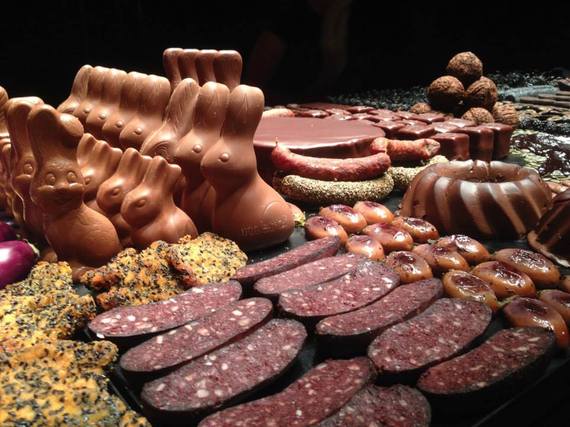What is alpine cuisine? And could that be the approach allowing Austrian food to position itself internationally, just like it happened for the New Nordic Cuisine? Those were some of the topics examined during "Culinary Art 2015: Gates to the future", a two-day conference on food and eating that took place on March 16 and 17 in the beautiful city of Salzburg, in Austria, where local restaurateurs, hospitality professionals, tourism experts, as well as scholars and writers, discussed food and eating in theory and practice.
I had the opportunity to meditate on food, desire, and pleasure with Austrian philosopher Robert Pfaller and writer Christian Seiler, in conversation with an audience composed for the most part of professionals who had very interesting insights on a theme that turned out to be all but speculative. Panels and conversations developed around food design, sensory science, trends and innovation, animated by relevant European experts. Architects Sonja Stummerer and Martin Hablesreiter, professionally known as Honey & Bunny, created a spectacular and thought provoking evening performance that prodded participants to reflect on table manners, taboos, and commensality. More about them and their work in upcoming posts...
It is intriguing that a city like Salzburg, famous worldwide for its opera festival and other prestigious yearly events that attract social jetsetters as well as cultural movers and shakers in throngs, took the initiative to focus on food not only as the possible core for more popular happenings in the future, but also as a complex and crucial subject for the Austrian hospitality industry.
What emerged in the discussion is the struggle for Austrian cuisine to acquire a precise and readable distinctiveness. As a matter of fact, most tourists have little or no knowledge of the local dishes, culinary traditions, or even ingredients, and as a consequence they stick to a couple of classics, like Wiener Schnitzel and Gulash, that often turn into stereotypes. This sort of tunnel vision is extremely frustrating for the industry members and entrepreneurs who aim to explore different venues, both in terms of traditions and innovation, who invest on high quality product, and who are proud of their culinary identity as Austrians. Is it a communication issue, or are there more structural reasons for these dynamics?
The conference participants were looking for viable solutions to these dilemmas, and for this reason they where very interested in the keynote speech delivered by Claus Meyers, founder with René Redzepi of NOMA restaurant in Copenhagen and a well known spokesperson for the New Nordic Cuisine, of which he helped write the manifesto. In little more than a decade, the food from Denmark and the other Scandinavian countries has caught the attention of chefs, critics, and customers all over the world. Based on the research of indigenous ingredients, the collaboration with local producers, the reflection on shared cultural values such as "purity, freshness, simplicity," and the openness to impulses from other countries, the New Nordic Cuisine has stimulated great advances in the hospitality industry of Northern Europe.
The Austrian food professionals participating in the Salzburg conference clearly consider what's happening in Scandinavia as a great example. However, they know that a good model cannot just be copied and that they need to find their own voice. The result may be "Alpine Cuisine," highlighting the uniqueness of the food and products of the Alp, including cheese, meat, fruits, berries and many leafy and root vegetables. Like the New Nordic Cuisine, Alpine Cuisines are found in countries other than Austria, such as Switzerland, Italy, Germany, and Slovenia, with many shared characteristics in terms of ingredients, practices, and values. Alpine Cuisine would probably have great appeal both for locals, who would see their cultural identity valued, and tourists, for whom the mountains constitute a great attraction in the region.
However, it will be necessary for food professionals in neighboring countries to find a common language to communicate successfully the identity of those culinary traditions. Chefs, producers, and marketers will have to agree on core values and practices, take some risks in their strategies, and examine with attention the potential and the shortcomings of the local food systems. A very tall order, but one that is worth a well-organized attempt.
